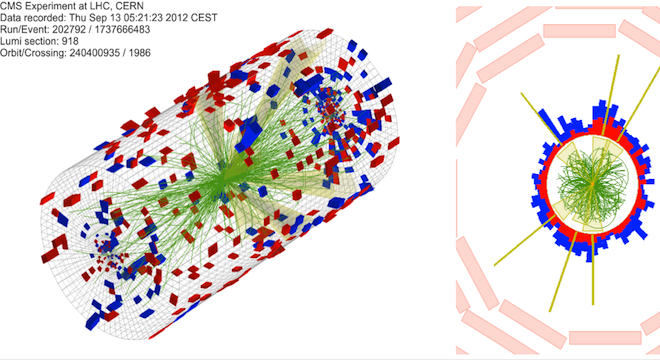The Large Hadron Collider, the world’s largest and most powerful particle accelerator and the “Big Bang machine” that was used to discover what appears to be the long-sought Higgs boson particle (as announced July 4), may have another surprise up its sleeve this year: The LHC looks to have produced a new type of matter, according to a new analysis of particle collision data by scientists at the LHC’s Compact Muon Solenoid (CMS) collaboration, including researchers at MIT and Rice University.
The new type of matter, which has yet to be verified, is theorized to be one of two possible forms: Either “color-glass condensate” — a flattened nucleus transformed into a “wall” of gluons, which are smaller binding subatomic particles, or it could be “quark-gluon plasma,” a dense, soup or liquid-like collection of individual particles.
“The color-glass condensate is one of the two most prominent possible explanations for the effect we have seen, with the other being the creation of a dense ‘liquid’ system that expands and leads to the observed correlations,” wrote Gunther Roland, an MIT physicist who led the analysis of the collisions and is a co-author on a paper on the results, due to be published in an upcoming issue of the journal Physical Review B, in an email to TPM.
“Formation of a quark gluon plasma in the much smaller [proton-lead collisions] system would be considered rather surprising,” Roland wrote to TPM. “It only exists at extremely high temperature (several trillion degrees Kelvin).”
Either of these strange types of matter would have been around at the start of the Universe, shortly after the Big Bang (hence the Large Hadron Collider particle accelerator’s nickname). The color glass composite is also considered to be a precusor to the quark gluon plasma.
Color-glass condensate in particular may have been detected previously in collisions of other types of particles at the LHC and its smaller and less powerful predecessor, the Relativistic Heavy Ion Collider (RHIC) at Brookhaven National Laboratory in Long Island, New York, though those results are disputed as well.
But what makes the new observations so remarkable is that they occurred following just four hours worth of collisions of protons and lead ions in the Large Hadron Collider, which weren’t expected to produce the new type of matter.
The results were detected in September by one of the six different major experiments running off the Large Hadron Collider, the CMS experiment. CMS first reported on the results in October, when the researchers first submitted their paper, but it was only recently accepted for publication.
“It was supposed to be sort of a reference run — a run in which you can study background effects and then subtract them from the effects that you see in lead-lead collisions,” Roland said in a statement in MIT’s News article on his discovery.
The LHC’s primary purpose to collide different types of highly-energized particles together at near light speed to recreate the conditions of the universe in the few micro-moments immediately following the Big Bang. Scientists then analyze the debris produced in the wake of these collisions for clues about what matter and the physical universe was like in its earliest form, attempting to further our understanding of how anything exists at all and why the laws of the universe operate as they do.
In this case, the team analyzed the data from two million collisions of protons (positively charged subatomic particles) and lead ions (lead atoms stripped of their electrons), only to stumble across the fact that some pairs of particle debris were flying away from the collision point in the same direction — they were correlated, in other words, a strange result because they shouldn’t have been related.
The LHC had only just begun colliding these two types of particles together in September, so the surprising results are doubly impressive.
Still, the team behind the incredible results plans to attempt to replicate them using the same type of collision for a longer time period — several weeks this time — in January.
As for what impact the new results may have on the recently-discovered evidence of the Higgs boson, Roland said they wouldn’t force scientists to change too much — yet.
The results are “not related to the Higgs boson properties directly, due to the very different energy scales involved, but may be influencing the rate of background processes that need to [and are] be considered in the Higgs studies,” Roland explained to TPM.
Correction and editor’s note: This article originally quoted an MIT News article stating that the results of the CMS observations would be published in the journal “Physics Review B” when in fact, the correct name of the journal is “Physical Letters B.” We have since corrected the error in copy and regret it. This article was also updated after publication to clarify that the entire CMS collaboration was involved in analyzing the results, not just scientists at Rice and MIT.






